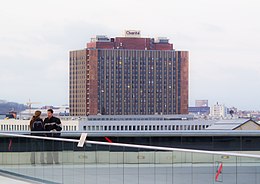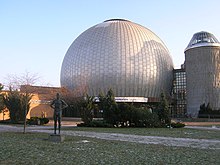Erhardt Gißke
Erhardt Gißke (also Ehrhardt Gisske ; born March 2, 1924 in Schönstedt ; † July 19, 1993 in Berlin ) was a German architect and general building director of the GDR . Some of the most important buildings of the GDR in East Berlin were built under his leadership .
life and work
After graduating from elementary school, Gißke completed an apprenticeship as a bricklayer , then studied at the Staatsbauschule (building trade school) Gotha architecture (1941–1943). At the age of 18, in 1942, he joined the NSDAP , after the war he became a member of the KPD and in 1946 with the forced unification of the SPD and KPD a member of the SED
After successfully completing his studies, Gißke worked in the planning department of a state- owned construction company in Bad Langensalza .
When the town of Bruchstedt was about 80 percent destroyed by a flood catastrophe on May 23, 1950 , the First Secretary of the SED state leadership in Thuringia, Erich Mückenberger, appointed Erhardt Gißke as head of construction in order to organize a quick reconstruction, which was within only succeeded for 50 days. In Thuringia Gißke then worked in architects' collectives who were commissioned with the construction of the Oberhof winter sports center (Oberhof luge track , ski jumping facility in Kanzlersgrund and others) in the Thuringian Forest and the construction of sports facilities in Leipzig.
In East Berlin in the 1950s, GDR construction activity was concentrated on Stalinallee , in which the NAW played a larger role. The Berlin magistrate commissioned Erhardt Gißke with the technical management, initially for the organization of the rubble railway , with the use of which the war-torn ruins in this area were removed; the rubble railway ceased operations here in 1955. In 1956 Gißke was appointed deputy to the chief architect of Berlin, Hermann Henselmann , with which he was responsible for the structural implementation of Henselmann's urban plans and architectural projects.
In 1958 the Berlin magistrate appointed Erhardt Gißke as building director. In 1964 he became director of the Institute for Industrial Construction at the Building Academy of the GDR , where he received his doctorate in 1969 and was appointed professor in 1973 . In 1973 Gißke became general director of the construction management for special projects in the capital Berlin , then general director of the Berlin construction department . In this function, he was particularly responsible for the planning collectives and he was responsible for the procurement of materials and the deployment of construction workers, with construction soldiers from the NVA also being used to build the buildings.
Erhardt Gißke was significantly involved in the implementation of the following representative building projects from the Erich Honecker era in East Berlin :
|
|
Henselmann dedicated an obituary to him on July 24, 1993 under the title A maker of passionate thirst for action in New Germany .
Honors
Gißke was awarded the Patriotic Order of Merit in Gold (1979) and the Karl Marx Order (1984). He was awarded the National Prize of the GDR three times: in 1969 he received III. Class for science and technology, 1976 in first class for science and technology and 1986 in second class for art and literature.
Publications
- Build - my life . Dietz, Berlin 1988, ISBN 3-320-01410-2 (author).
- Nikolaiviertel and Friedrichswerder Church. Construction and reconstruction . Building Academy of the German Democratic Republic, Berlin 1988 (Mitw.).
- Building in Berlin. 1973-1987 . Koehler et al. Amelang, Leipzig 1987, ISBN 3-7338-0040-0 (Ed.)
literature
- Bruno Flierl : Built GDR - About urban planners, architects and power . Verlag für Bauwesen Berlin, Berlin 1998, ISBN 3-345-00655-3 .
- Simone Hain, Helmut Müller-Enbergs : Gißke, Ehrhardt . In: Who was who in the GDR? 5th edition. Volume 1. Ch. Links, Berlin 2010, ISBN 978-3-86153-561-4 .
Web links
- Erhardt Gisske. In: arch INFORM .
- Literature by and about Ehrhardt Gisske in the catalog of the German National Library
- Erhardt Gißke remembers , broadcast of the mdr on June 21, 2010 (historical film and sound recordings for the reconstruction of Bruchstedt)
Individual evidence
- ↑ Erhardt Gißke in the Munzinger archive ( beginning of article freely available)
- ↑ Hermann Henselmann: A maker with a passionate drive . On the death of Erhardt Gißke. In: Neues Deutschland , July 24, 1993
- ↑ Neues Deutschland , October 4, 1969, p. 6.
- ^ Neue Zeit , April 23, 1976, p. 3.
- ↑ Neues Deutschland, October 8, 1986, p. 4.
| personal data | |
|---|---|
| SURNAME | Gißke, Erhardt |
| ALTERNATIVE NAMES | Gisske, Ehrhardt |
| BRIEF DESCRIPTION | German architect |
| DATE OF BIRTH | March 2, 1924 |
| PLACE OF BIRTH | Berlin |
| DATE OF DEATH | July 19, 1993 |
| Place of death | Schönstedt |





